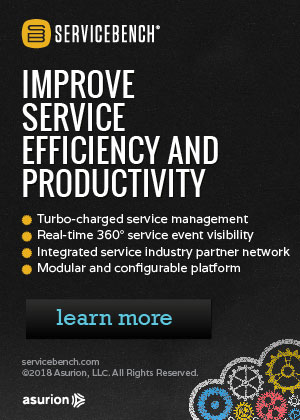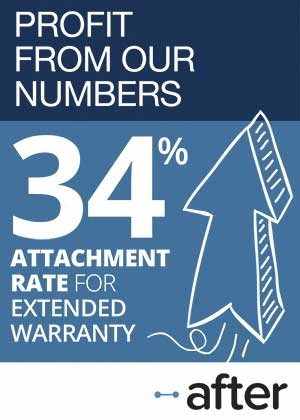Semiconductor Warranty Report:
Though the companies making capital equipment that's used to fabricate and test semiconductors and printed circuit boards continue to pay more warranty expense than their manufacturing customers, the gap has narrowed considerably over time. Some companies have cut their expense rates in half.
Normally, the suppliers get away with paying far less warranty expenses than their clients. However, the companies that supply semiconductor and printed circuit manufacturers with the machinery they use to make and test the devices pay far more than their clients. But that's changing, as the capital equipment suppliers find ways to cut their warranty costs considerably.
We began the process of analyzing the warranty expense data of the U.S.-based semiconductor industry by gathering certain metrics from the financial statements of some 161 manufacturers engaged in the business. We collected figures for the amount of claims paid, accruals made, and reserves held, as well as product sales figures. And with those sales figures, we calculated two additional metrics for claims paid as a percentage of sales, and accruals made as a percentage of sales.
When we began collecting this data back in 2003, we noticed that a small subset of the 161 companies were putting a much higher percentage of their sales towards warranty expenses than were the majority. It was then that we noticed that most of these high-cost companies were manufacturing the equipment and machinery that is then used to fabricate and test the actual printed circuits and semiconductors, while most of the low-cost companies were their clients.
Back then, the capital equipment companies were spending two, three, or even four percent of their revenue on warranty expenses, while their clients were closer to 0.7%. In other words, the companies that make the production machinery and test equipment -- the suppliers, if you will -- were paying high warranty costs while their customers were paying less.
It's a pattern that we've seen in other industries, but not to such a large extent. For instance, most of the homebuilders report warranty expense rates that are somewhat lower than the companies making building materials, fixtures, furniture, and appliances. But there were never gaps between them of two to three percent.
Narrowing the Gap
In this industry, the gap seems to have narrowed over time. But before we can get to that point in the story, let's get some details on the actual expenses.
In Figure 1, we're tracking the warranty claims paid per year by 22 companies that make the semiconductor and printed circuit board manufacturing equipment, and 139 companies that make the actual semiconductors and PC boards. In all but two of the last 14 years, the makers of the manufacturing equipment have paid well over half the industry's total claims.
For instance, last year the equipment makers paid two-thirds of the industry's total bill of $454 million. And that was actually their highest-ever share of the total, though it wasn't the highest total ever. In fact, it was the lowest-ever total, falling $29 million below the year before's $483 million total. However, that was mainly due to the declines in claims paid by the clients; the equipment makers have been paying roughly $300 million a year since 2013.
Figure 1
Worldwide Warranty Claims Paid
by U.S.-based Semiconductor & PC Board Manufacturers
(in US$ millions, 2003-2016)

The biggest name on our equipment manufacturing list is Lam Research Corp. And it continues to get larger, both through organic sales growth and acquisitions. Back in 2012 it bought Novellus Systems Inc. Last year it was expected to acquire KLA-Tencor Corp., but that deal collapsed after anti-trust objections were raised. but its revenue continues to grow, as do its warranty expenses.
The second-biggest warranty provider on the list is Applied Materials Inc., and then KLA-Tencor Corp. is third. On the list of their clients, Cree Inc. is now the largest warranty provider, followed by Advanced Micro Devices Inc., Teradyne Inc., and Nvidia Corp. We should note that market-leading device manufacturers such as Analog Devices Inc., Intel Corp., Micron Technology Inc., and Texas Instruments Inc. do not report their warranty expenses publicly, so they're not part of either group. Nor are the importers or internationally-based manufacturers.
Claims Totals Remain Steady
Last year, the claims totals of the U.S.-based capital equipment group as a whole rose only slightly, but only because the increases and decreases seemed to cancel each other out. For instance, Lam Research saw claims rise by $15 million, but Applied Materials cut its annual claims cost by $8 million, while KLA-Tencor cut its by $5 million. For the group as a whole, warranty claims rose by $1 million, far less than a one percent increase.
On the other side of the industry, one of the biggest declines in claims payments was reported by Maxim Integrated Products Inc. It cut its claims cost from $20.5 million in 2015 to $8.8 million in 2016. But it only began reporting its warranty expenses in fiscal 2014 -- its 2013 annual report stated that "warranty expense has historically been immaterial to the company's consolidated financial statements." Perhaps if they continue declining that quickly, those expenses will resume being immaterial to what is now a two-billion-dollar company? We hope not.
Others with material declines in claims costs included Advanced Energy Industries Inc., which cut its annual bill from $10 million in 2015 to $1.1 million in 2016. AMD reduced its claims cost from $26 million to $19 million. And Nvidia cut its claims cost down to $12 million a year, almost a third less than in 2015. By the way, most of the reason claims cost soared for the device makers in 2009 and 2010 was due to the manufacturing problems Nvidia had with its graphics boards.
The biggest driver of recent drops in claims costs, however, are the numerous acquisitions that have taken some of the top players off the list of warranty-expense-reporting companies. Just in the past year, we note the departures of Cascade Microtech Inc., FEI Company, Multi-Fineline Electronix Inc., and Rofin-Sinar Technologies Inc. In 2015, we lost Anadigics Inc., Applied Micro Circuits Corp., Atmel Corp., Magnetek Inc., and PMC-Sierra Inc., among others. Sometimes the acquiring companies report the acquired warranty expenses. But other times, they're non-reporters, either because they don't feel like it, or because they're based beyond the reach of U.S. accounting rules.
However, there were also some spectacular increases in claims cost. Cree Inc. saw claims costs double, even though sales are declining. ON Semiconductor Corp. saw claims more than triple in 2016, though sales were up only 12%. Clearly, for them, warranty costs are far from immaterial.
Warranty Accruals Rise and Fall
The amount each company sets aside per year in warranty accruals can be even more revealing. From time to time, every company has a bad batch that goes out and raises claims costs. But they detect the problem and they fix it, and claims return back to normal levels. Accruals, on the other hand, are made based on what a company expects to happen in the future, and unless there's an ongoing problem or a major change in the product mix, they should remain more or less proportional to sales over time.
In Figure 2, we can see that accruals rose by $29 million last year for the manufacturing equipment group, while they fell by $38 million for the device group. That led to a net $9 million decline for the entire industry, from $542 million in 2015 to $533 million in 2016. It was the highest annual total for the capital equipment group since 2011, and the lowest-ever annual total for their clients.
Sales, however, rose faster than accruals for the capital equipment group, and rose faster yet for their clients. In other words, accruals as a percentage of sales fell for both groups, because sales rose faster than expenses. But let's not get ahead of ourselves.
Figure 2
Worldwide Warranty Accruals Made
by U.S.-based Semiconductor & PC Board Manufacturers
(in US$ millions, 2003-2016)

Among the largest warranty providers in the industry, accrual increases prevailed last year. Applied Materials increased accruals by $18 million. Cree increased accruals by $17 million. Lam Research increased accruals by $14 million. And Coherent Inc. increased accruals by $5.4 million. Among the largest companies, AMD reported one of the few accrual reductions, taking its annual total from $28 million in 2015 to $21 million in 2016.
All but Cree also reported sales increases as well. And all but Applied Materials and Teradyne Inc. saw sales rise faster than accruals. So although some of the annual increases were large, they generally resulted in lower expense rates, as measured by accruals as a percentage of sales. But once again, we're jumping ahead.
Warranty Reserves Increase
In Figure 3, we can see that year-ending warranty reserve balances rose last year to their highest level since 2011, a combination of a $59 million increase for the capital equipment makers and a $15 million reduction by their clients.
Besides changes in claims and accruals, these balances are affected by foreign exchange fluctuations as well as by acquisitions and mergers. So it's not as simple as accruals minus claims equals reserves. But we note that for the capital equipment makers, it was their highest reserve balance since 2007, while for their clients it was the second-lowest level of the last 14 years, bested only by 2013's $241 million balance.
Figure 3
Worldwide Warranty Reserves Held
by U.S.-based Semiconductor & PC Board Manufacturers
(in US$ millions, 2003-2016)

Once again, increases predominated. Applied Materials saw its reserve fund balance rise by $27 million. Lam Research saw an increase of $22 million. Cree saw a $15 million increase. And Coherent saw a $14 million increase.
On the flip side, Maxim cut its reserves by $6.1 million. Nvidia cut its reserves by $6.0 million. And AMD cut its reserves by $3 million. All of these changes represented increases or decreases of 20% or more from 2015 levels.
Warranty Expense Rates Decline
Finally, we have enough data in hand to take a look at the actual claims and accrual rates. In Figure 4, we've charted the data from Figures 1 and 2 not in dollars but as a percentage of all these companies' sales. And that tells the real story.
The red lines represent each group's claims rate, while the green lines represent their accrual rates. As we noted, accrual rates should not change by much unless there's been a change in outlook in terms of product reliability or repair cost. Claims rates, however, are severely impacted during economic downturns, because companies are paying for last year's problems with this year's revenue.
That phenomenon explains the giant spike in 2009, and the recovery in sales during 2010 and 2011 explains the excursion in the opposite direction. And notice how in early 2010, while the claims rate of the capital equipment companies was plummeting, the claims rate of their clients was spiking, to the point where they almost met. Those sure were wacky days.
But the great news in Figure 4 is the long-term decline in expense rates for both groups. Secondarily, the gap between them has narrowed considerably. Back in 2003 there was two or three percent of space between them. Now the gap is more like one-and-a-half percent.
Figure 4
U.S.-based Semiconductor & PC Board Manufacturers
Average Warranty Claims and Accrual Rates
(as a % of product sales, 2003-2016)

Some of the capital equipment companies have made spectacular progress when it comes to reducing their warranty expense rates. For instance, both Applied Materials and KLA-Tencor reduced their claims rate from 3.1% at the end of 2003 to only 1.2% at the end of 2016. Lam Research cut its claims rate from 2.3% to 1.7% over the same time period.
In terms of accrual rates, some of the changes are even more incredible, especially among the smaller capital equipment companies. Back in 2003, Axcelis Technologies Inc. had an 11% accrual rate. Now it's 1.3%. Ultratech Inc. cut its accrual rate from 3.9% in 2003 to 1.4% in 2016. And among the larger players, Applied Materials, KLA-Tencor, and Coherent brought down their accrual rates by one percent or more.
Among the actual device makers, the story is more mixed. From 2003 to 2016, AMD cut its claims rate from 0.7% to 0.4%, and its accrual rate from 1.1% to 0.5%. Nvidia cut its claims rate from 1.2% to only 0.1%, while its accrual rate fell to only 0.02% by the end of last year. But Cree saw its claims rate rise from 0.2% to 2.0%, while its accrual rate rose from 0.8% to 3.0% over the same time period.
And although the way the chart is drawn makes it hard to tell, the 1.3% claims rate turned in by the capital equipment group in the fourth quarter of 2016 was their lowest reading since the wacky days of 2010. And their collective accrual rate has been below two percent in nine of the past 12 quarters. That's a major change from 14 years ago, when their claims rate touched four percent and their accrual rate topped 3.5%.









